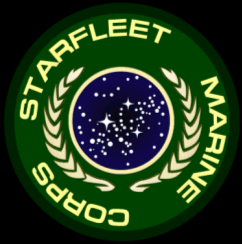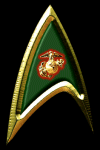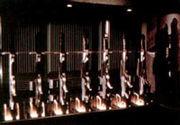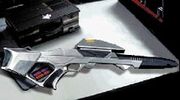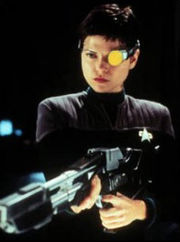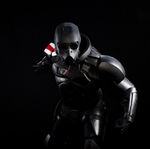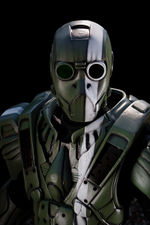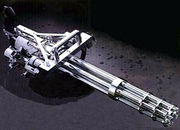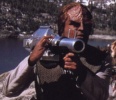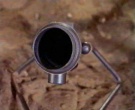Starfleet Marine Corps
From Starbase 900 Wiki
The Marine Corps shall be organized, trained, and equipped to provide Fleet Marine Forces of combined arms, together with supporting aerospace components, for service with the fleet in the seizure or defense of advanced bases and for the conduct of such space or planetary operations as may be essential to the prosecution of a campaign.
Starfleet exists to conduct prompt and sustained combat operations in space and project power through out Federation space as necessary. In support of Federation interests, Starfleet is charged with three main functions-space control, power projection, and strategic space transport. Closely aligned with these operations are various other roles of Starfleet -deterrence, defense of the Federation, commerce protection, and presence.
A measure of control of the space is essential to the successful execution of all Fleet roles and missions. Space control is simply the ability to use space more freely than the enemy does. Deterrence is prevention-preventing an attack from occurring. Defense of the Federation involves a "forward offense" of taking the fight to the enemy and away from the Federation . Power projection is the application of space-based power, whether that power lies in Starship based space strikes, or the landing of Marines or other Special Forces. Commerce protection is keeping our resource and supply lines of communication open while closing those of the enemy. Presence is the execution of influence in conditions shy of combat, to encourage others to take action we desire, or to discourage them from taking actions that are not in our best interests.
In contrast, as an expeditionary, combined arms, force-in-readiness, the Marine Corps must provide forces that can be rapidly deployed for contingency missions to support Federation security objectives. The Marine Corps' primary mission is to provide fleet marine forces of combined arms, including integrated aerospace, ground and logistical components, for service with the Fleet as part of a Mobile Marine Task Force (MMTF). These two dimensions-the expeditionary focus and the combined arms concept-make the Marine Corps a unique military organization. No other Federation military organization is trained or equipped to conduct space born planetary assaults and subsequent operations on planet on the same significant scale.
The Marine Corps may serve in purely planetary campaigns, but is organized primarily as a Fleet expeditionary force-in-readiness. The Marine Corps' portion of this joint force is to function essentially as a highly integrated command aerospace-ground-logistic expeditionary force capable of executing a full range of operations. Inherent to the successful execution of the Marine Corps' mission is its affiliation with the strategic and tactical flexibility of Starfleet and Marine aerospace forces.
Whereas the Corps has made many major innovations and changes, one vital ingredient remains constant-the Marine Corps is prepared today to respond immediately to the Federation's call. For example, Mobile Marine Task Forces (MMTF), which vary in size, are immediately available to a force commander. Also, the Marine Corps has retained it's distinct expeditionary orientation and force structure, as well as its usefulness, across an entire range of anticipated threats facing our security. This expeditionary capability is an essential element of Federation defense strategy because ready forces cannot be based everywhere in Federation space. Expeditionary forces can be introduced swiftly and withdrawn quickly; they are independent of base ; and they give Federation command authorities a wide range of options during crises. The requirement for a responsible expeditionary capability was validated by a Presidential Starfleet Commission in a report titled "Deadly Deterrence" (SD 4406.06), which endorsed "versatile, mobile forces, minimally dependent on planetary bases, that can deliver precisely controlled strikes against distant military targets" as the force of choice for protecting Federation security interests.
Starfleet is not primarily a military organization. Despite its military ranks and procedures, its frequent space battles, and its ships that carry enough firepower to bake the crust of a planet, Starfleet is devoted primarily to the peaceful exploration of space and the policing of Federation spacelanes. However, there are times when military intervention on a planet becomes necessary, and when those times come, the Federation maintains an elite force of soldiers - Starfleet Marines. Starfleet Naval personnel serve a wide variety of purposes, diplomatic as well as scientific. Starfleet Marines serve only one purpose - combat - and they are used if diplomacy fails.
Even when forgotten, the Starfleet Marine Corps is always hard at work upholding the ideals of the Federation while guarding it from any adversary that may present itself. In true military fashion, officers of the SFMC place the lives of others before their own, ready to sacrifice anything for their government.
Marines are carried aboard Starfleet ships, but they have their own commanders and are separate from the regular shipboard chain of command. Twenty-fourth century technology, and particularly Holodeck technology, have made it possible to give rank-and-file soldiers the kind of intensive military training that was the sole preserve of special forces units a mere four centuries before. Starfleet Marines are exceptionally well trained and capable, even by Starfleet standards. They are meant to operate primarily on planetary surfaces, both land and water, but are also trained to participate in space-based operations as well. Their skills reflect the fact that they frequently have to operate in a long-range reconnaissance fashion, often with little or no support from Starfleet.
Unlike Naval personnel, Starfleet Marines must meet exacting physical criteria. They are particularly expected to display above-average intelligence and exceptional endurance.
The first difference between the naval and marine branches of Starfleet that one notices is the rank system. Carried down from generation to generation, the system resembles quite closely the ranking method used in 20th century Earth. The next difference is the militaristic nature of the corps. While the Starfleet navy tends to maintain order in a loose but firm manner, some have called the Marine Corps' management technique stringent or even harsh. Quite simply, Marine commanders do not tolerate anything less than the absolute best in their men, knowing that to do so would risk the lives of others. There is little room for error in such a dangerous and important field.
Contents |
Starfleet Marine Corps History
The Federation Council mandated the creation of Starfleet Marine Corps in 2243. Starfleet Command had voiced it’s concern over certain aspects of Federation Security Policy and following a number of incidents including the less than acrimonious First Contact with the Klingon Empire a number of senior officers in Starfleet began developing a proposal to the Federation Council.
The formation of the Starfleet Marine Corps developed slowly as a sub-division of Starfleet Intelligence as it was used mainly for covert operations and reconnaissance especially in border areas between the Romulan Star Empire and the Klingon Empire.
The Corps was officially known as Starfleet Rapid Reaction Unit and comprised of four Insurgency Teams under the command of Lt Commander Thomas Maguire.
By 2283 the S.R.R.U had been involved in a number of operations and developed a reputation within Starfleet as the elite security detail. By then Starfleet Command decided to further develop the unit and expand it’s operations. Lt Commander Maguire received high praise from Starfleet Command and was promoted to Commander. In 2288 Commander Maguire presented a proposal for a new structure for the unit and a new name, Starfleet Marine Corps.
Starfleet Command approved the new name and the revised structure. Starfleet Marine Corps became a separate entity but still had close ties to Starfleet Intelligence and also Starfleet Security. As a result of the change Commander Maguire became Lt. Colonel Maguire, Chief of Marine Operations, Starfleet Marine Corps. A Flag Officer was assigned by Starfleet Command to take overall command of the Corps.
Rear Admiral David Hawkins became the first Corps Commander. Admiral Hawkins devised the Marine Training Command at Starfleet Academy to train new Marines officers and opened former Marine training facilities on Earth for enlisted personnel. He helped devise the Training Manual for Marines along with Colonel Maguire.
By 2299 the Marines became an established part of Starfleet and were growing in size and it became the Federation’s main security unit for specialist operations.
Rear Admiral David Hawkins became Field Marshal Hawkins in 2306 and was the first Commandant of the Marine Corps. By this stage Colonel Thomas Maguire had become General Thomas Maguire and was the Corps Executive Officer and Director of Marine Operations. Starfleet Marines was divided into various levels. As well as the designated officers there are others assigned to specialist posts.
The expansion and development of Starfleet Marines grew over the years. Following the retirement of Commandant Hawkins and General Thomas Maguire in 2324 General Peter Guflauson became Commandant and Major General Kalgor Chanduri became a General and Starfleet Marines XO.
Commandant Guflauson and General Chanduri led Starfleet Marines through many successful assignments and campaigns. Both Commandant Guflauson and General Chanduri retired in 2337. They were replaced by Commandant Gr'ixth Mishtal and General Audrey Delray, marking a milestone in SFMC history with the first non-human Commandant and the first female to hold the rank of General.
After many years of innovation in the Corps, both Commandant Mishtal and GEN Delray were applauded for their contributions. They spearheaded the Marine Cavalry Corps in 2352 and resurrected Force Recon, taken from the United States Marine Corps of the 20th century. Both the Cavalry Corps and Recon units, as well as the entire Corps, were put to the test during the Dominion War. Both Mishtal and Delray were killed during the Dominion War in separate operations, however. A Changeling infiltrated Starfleet Marine Command and assassinated Commandant Mishtal while General Delray was killed when a Jem’Hadar Cruiser destroyed her shuttle.
In 2375 Starfleet Marines had a new Commandant, Field Marshal James L. Madigan and a new XO, General Christopher Raven. Commandant Madigan and General Raven continued the innovation of the Corps that Mishtal and Delray started and made many more changes that made the Corps grow.
Starfleet Marine Corps Unit Organization
The SFMC is arranged in a variety of units, each having its own distinct command structure and organizational divisions. The largest unit in the Marine Corps is the division. A division is usually comprised of two or more Brigades. Normally commanded by a Lieutenant or Major General, LGen. and MGen. respectively, a division is a self-contained entity in the corps. Reporting directly to Marine Corps and Starfleet Commands, the division command is responsible for supporting all of the subordinate units under its flag. A division's mission can be varied or consistent. Divisions are named in order of creation beginning with 'first,' e.g. First Division (1DIV). An average division consists of approximately 24,000 officers and troops.
Within a division there are several brigades. Brigades are the largest units capable of mobilization in strategic sectors of the galaxy. A brigade contains two to six regiments. A brigade is the largest possible Marine Corps unit to be assigned to a starbase. Customarily a brigade is commanded by a Brigadier General, BGen, who reports to his/her division commander. Brigades can be spread out over many sectors and is responsible for supporting the regiments under its command. Brigades are named in order of creation beginning with 'first,' e.g. First Brigade (1BGD). Often regiments in a brigade are given specialized tasks to perform. A brigade is comprised of approximately 12,000 officers and troops.
A regiment is the largest possible specialized unit in the corps. Consisting of four to eight battalions, regiments are commanded by officers holding the rank of Colonel (Col) who, in turn, report to the proper brigade commanders. For the most part, regiments are specialized, each given a special task to perform within a division. A regiment is responsible for a general mission profile, while allowing each sub-unit to diversify as well. Regiments are given distinct names, based often from their origins, overall mission profile, or even their first commander, e.g. 'First Division, Third Brigade, Orion Regiment (1DIV, 3BGD, Orion REG).' Unless noted with a designator, a regiment, battalion, or company is a combat forces unit. On average, a regiment consists of approximately 3,000 officers and troops.
The largest Marine Corps unit to be assigned to a starship is a battalion. Comprised of a three to six companies, battalions are commanded by Lt. Colonels (LCol). Leading the battalion from a specialized company denoted Headquarters Company (HQ CO), the Marine Commanding Officer in charge of a battalion reports to his appropriate regiment commander. In addition to the specialization of each regiment, battalions are also given specific tasks within the larger Marine organization. Battalions assigned to starship duty are solely combat forces battalions. As with brigades, battalions are identified by their creation date, e.g. 'First Division, Third Brigade, Orion Regiment, Second Battalion (1DIV, 3BGD, Orion REG, 2BN).' Average battalions consist of approximately 500 officers and troops.
A company is the smallest unit capable of independent action in line duty. Comprised of a minimum of two platoons, three or four being the recommended number, a company is led by a Major or Captain, Maj and Capt respectively. Each company command reports directly to their battalion command with the exception of the Headquarters Company. The Headquarters Company consists of the battalion commander, his staff, as well as various aides, clerks, and support staff. Companies are identified with a letter from the Roman Alphabet or as Headquarters Company (HQ CO), e.g. 'First Division, Third Brigade, Romthar Regiment, Second Battalion, D Company (1DIV, 3BGD, Romthar REG, 2BN, D CO).' Average companies consists of approximately 110 officers and troops.
The smallest field command, comprised of an average of six six-man squads, is the platoon. Commanded by a Lieutenant or Second Lieutenant, Lt and 2Lt respectively, a platoon command reports to the company commander with the exception of those men who serve in the Headquarters Company as support staff. A platoon in the Headquarters Company reports directly to the designated battalion command representative. Platoons are identified with a letter in the phonetic alphabet, e.g. 'First Division, Third Brigade, 2nd Andorian Regiment, Second Battalion, D Company, Platoon Echo (1DIV, 3BGD, 2nd Andorian REG, 2BN, D CO, Platoon Echo).' For the most part, a platoon consists of 40 men.
Marine Corps Unit Summary
| Unit Name | Comprised Of | Ave. # of Men | Commanded By | Naming Example |
|---|---|---|---|---|
| Starfleet Marines | All Marines | 300,000 | Field Marshal | Starfleet Marine Corps |
| Corps | 3 Divisions | 140,000 | Lieutenant General | 2D Marine Corps |
| Division | 4 Brigades | 35,000 | Major General | 15th Cavalry Division |
| Brigade | 5 Battalions | 6,500 | Colonel | 4th Force Recon Brigade |
| Battalion | 5 Companies | 1,250 | Lieutenant Colonel | 17th Marine Expeditionary Unit |
| Company | 5 Platoons | 250 | Major / Captain | B Company |
| Platoon | 4-5 Squads | 32 | 1st/2nd Lieutenant | Echo Platoon |
| Squad | 6-8 Marines | 7 | Staff Sergeant | First Squad |
The average men per unit is just a rough number, not an absolute. The CO ranks are what is customary but this is also just a guideline.
Marine Corps Operations
SFMC operations are indirectly controlled by the Fleet Admiral. Allowing broad discretionary powers to the field commanders themselves, the Fleet Admiral is responsible for major and long-term deployments, extended campaigns, and various special tours of duty that do not fall under the jurisdiction of any field command. In doing, the Marine Corps unit commanders are given the power to evaluate and make decisions based on their own observations and calculations rather than having to continually check with their superiors. This by no means allows carte blanche, major decisions which do not fall under the unit's mission must be verified if possible. A Marine unit commander has similar decision powers to a Starship Captain.
On a smaller scale, units deployed aboard a starship operate under a similar, yet somewhat different, method. In addition to reporting to the regiment or battalion command in which the battalion or company serves, the Marine Commanding Officer (MCO) reports directly to the ship's captain. This instant communications and coordination allows both the naval and marine forces aboard the starship to conduct daily operations in a manner equitable to both sides. A starship-bound marine unit receives orders in much the same way. Long-term objectives are assigned by the unit's marine command while the vessel's CO is responsible for assigning short-term objectives. This has proven to be an effective method for those units assigned to serve aboard Starfleet naval vessels and installations.
Once graduated from Starfleet Marine Academy, the Marines officer is promoted to the rank of second lieutenant. There is a great deal of animosity between Starfleet naval and marine officers and crew. In short, they don't get along too well. The naval complement thinks the SFMC is home to a bunch of brash, arrogant, trigger-happy folk and the marine complement believes the Starfleet navy to be lax in discipline and training. The marines also believe that the navy takes the work of the SFMC too lightly.
Marine Corps Weaponry
Personal Small Arms and Armor
Though a Marine's own hands can be considered deadly and effective weapons, it is most often preferred to use an actual technological weapon in combat in order to maximize your ability to complete mission objectives. This list is a small portion of some of the small arms (that is, hand held weaponry) available.
Hand Held Knife
It should be noted that while the smallest item on this list is a hand phaser, the combat knife is still a basic part of the Marine's arsenal, as it has been for hundreds of years. Knife selection is usually up to the Marine's personal preference, though there are several standard types available. In addition, many Marines supplement their technological arsenal with one or more small hand weapons such as garrotes, throwing stars or knives, or bolos.
Type III Phaser Pulse Pistol ("3P", "Triple P")
The second generation phaser pulse pistol is the standard close combat sidearm issued to all Starfleet Marines. Pioneered in the mid 2370s, the PPP uses a similar firing method found in the Type IIIa compression phaser pulse rifle, but compacts it into a 'handgun' style configuration. Research has proven that the design not only is much easier to fire and aim than the Type II, but also has a much more profound psychological impact upon the target. This is partially due to the profound "theee-wump!" sound that the PPP gives off as it fires.
The refire rate on the PPP is staggering. The weapon is able to fire for extended periods, as fast as the user can pull the trigger. Depending on the setting, the side arm's power pack can fire as many as one hundred rounds (setting one).
The drawbacks to the PPP are it's increased size over the Type II, and its limitation of settings. There are only six options for power levels on the PPP. Two stun settings (equivalent to 2 and 3), two medium settings (equivalent to 4 and 6), and two heavy settings (equivalent to 7 and 9). However, the ease of use and ergonomics of the PPP outweigh these few limitations. Given the other side arms available for Marine use, and the close combat situation which the PPP was designed to operate under, the Marine Corps has deemed these drawbacks acceptable and the PPP is the one weapon that every Marine, no matter their specialty, carries.
Type IIIb Phaser Rifle
Although an older weapon, the Type IIIb phaser rifle still finds its way into certain Marine battalions who swear by its capability, as well as those Marine squads or platoons who are tasked with "low risk" assignments where the use of the heavier Type IIIc compression rifle is not warranted. Still built using the basic configuration of the original Type III rifle, the modern day equivalent, like the Type II, is virtually unchanged. The emitter crystal, like the Type II's, has been fully upgraded for a greater firing life and thermal resistance, but in addition to that, a second, larger power cell has been included to compliment the original cell.
Limited to beam fire only, the Type IIIb suffers from a few drawbacks not present in the Type IIIa, such as the revealing nature of beam fire, the need to dwell the beam on a heavily shielded target, and the greater wear on the emitter crystal. However, the Type IIIb still serves the Marine Corps with distinction, with its ability to mount virtually any scope or sensor systems on the almost universal attachment clamp.
Type IIIc Compression Pulse Rifle
Another weapon pioneered in the 2370s and perfected in the 2380s, this is the rifle that serves as the Marine Corps' primary small arm. Like the PPP, it is issued to every Marine as soon as they enter the service. First introduced in 2374, the IIIa revolutionized handheld phaser weaponry. Instead of firing a beam of energy, the IIIa used a high charge capacitance bank and a high-speed focusing coil which allowed the phaser discharge to be stored temporarily, and released as a layered pulse. The resulting pulse is much more difficult to disperse than a normal beam impact.
Over the years, the IIIa has gone through some radical modifications, eventually evolving into the type IIIc. In addition to upgrades made to the power cells, emitter crystals, and the capacitance bank, the focusing coils were upgraded and modified to allow the user to choose whether or not he/she wishes the standard pulse, or like the IIIb, a stream. Though the stream option produces a blast much less effective than the dedicated IIIb, it gives the compression phaser rifle the versatility of being able to fire in both modes. The Type IIIc Compression Pulse Rifle is accurate, durable, and versatile. In addition, the rifle can mount a variety of sensor/tracking sights in order to enhance accuracy.
M2-43 Plasma Pulse Rifle
The M2-43 is perhaps the current weapon most associated with the Starfleet Marine Corps. Developed exclusively for their use and based on the earlier TR-116 rifle, the PPR is a high-powered rifle which fires cased plasma rounds at a variable fire rate, but capable of over two thousand rounds per minute. The M2-43 is a hybrid weapon in that uses both kinetic and plasma energy in order to decimate the target. Using a high-powered subspace accelerator, the PPR feeds off a magazine (12x5x7cm) of 200 plasma rounds.
The plasma rounds themselves are small, but contain a massive amount of energy within them. Encased within a tritainum/duranium shell, the plasma energy is ignited by the subspace accelerator as it flung out of the rifle muzzle at near C. Upon impacting the target, the combination of the kinetic impact of shell and plasma mass, as well as the plasma's energy itself is devastating upon both unshielded and lightly shielded human size targets.
Especially effective when used in volleys by a squad, the M2-43 is capable of penetrating even some armored vehicles, opening up a second option if a dedicated anti-armor weapon is not available. The drawback of the M2-43 is its relatively short range. At 1km, the ignited plasma begins to dissolve the shell itself, and beyond 2km, the plasma has escaped the shell and dissipated over an area. The range limitation, however, can be compensated for through the use of a focused transporter emitter aligned with the rifle's subspace accelerator and mounted on the barrel of the rifle. With such an attachment and an exothermic imaging scanner (as pictured at right), the M2-43 becomes an outstanding sniper's rifle.
Beyond that, the M2-43 is an exceptional weapon. Easy to maintain, powerful against both unshielded and shielded targets, and psychologically devastating (the image of a fellow being shredded and spewed across the landscape in the blink of an eye can be quite unnerving), the M2-43 will be in use by the Starfleet Marine Corps for years to come.
Other Small Arms
The weapons mentioned here are, of course, a small example of those weapons you'll find within almost every typical Marine division. Each Marine, however, can come across a weapon which he or she gains a personal attachment to, and decides to use as his baseline or supporting weapon (with approval). Some of these weapons include the likes of Concussion Rifles (which fire a small shell based on a concussion grenade, but with a little antimatter thrown in), Disruptor Slug Cannons (using anti-protons and protons within a heavy shell to obliterate tanks or other armor), Tachyon Pulse Launchers, or plasma, disruptor or other phased energy rifles.
Light Combat Armor
In low hazard situations, Marines usually don the light combat armor, which is composed of 18 separate, but interconnecting armor segments which are snapped in place over a thermal and energy resistant body glove. The so called "clapper" suit (named due to the clapping noises made by the armor segments slapping together under quick movement) provides complete protection from energy blasts below level three, moderate protection up to level five (the armor may experience burn through, but the body glove will absorb the majority of energy which penetrates (akin to bulletproof vests of the 20th century), and protection from the lethal effects up to level eight (but medical treatment will be immediately necessary).
The strap on helmet of the "clapper" includes a complex communication's suite, and an articulated visor with built in anti viral, anti chemical filters, macro binoculars, and a basic sensor system.
Medium Combat Armor
This is the armor which the Marines wear most often into battle. It provides excellent protection from up to level six blasts with its reflective coating and built in shielding system, and can save a Marine from up to a level ten blast (again, immediate medical attention will be necessary). Instead of being interconnected over a body glove like the light combat armor, the "Hard Suit" is completely self contained, with flexible armored joints and a life support system that allows Marines to work in hostile environments for up to six hours of heavy exertion before the oxygen supply runs out.
The helmet of the "Hard Suit" clamps down upon the shoulder and neck portions of the armor, sealing the suit. The helmet, however, traverses with the wearer's neck movement, eliminating the need to turn in order to view what's to your sides. It contains a slightly more sophisticated sensor system then the "clapper", but the same communications gear. The medium combat armor is not comfortable, but this only assists the Marine in remaining alert. Mobility is almost as good as the "clapper," but is a little more restricted in a few methods of movement.
Because of its ease of disassembly, the light combat armor is stored in lockers in its separate clamshell pieces along with the underlying body glove. The medium combat armor, on the other hand, is a self-contained unit that is broken down into legs/waist, torso, and helmet sections available for a variety of body morphologies. These three components are stored in rotating tower sections that permit easy access and allow Oppenheimer's marines to quickly don them while at alert status.
Heavy Weapons and Equipment
Grenades
There are three major grenade types which the Marines aboard Hornet utilize: concussion, photon, and plasma. Concussion grenades detonate and use a pressure wave to incapacitate or kill their target. They are very stable, and have a large detonation range. However, the "kill" setting has proved to only internally fracture the target's bone structure rather than cause enough internal injury to cause death on most occasions.
Photon grenades are little changed since the 2200s, and are in a sense miniature photon torpedoes. They use a small amount of antimatter (a fraction of a gram) to achieve their effect. They are relatively stable; however, extreme situations can sometimes lead to premature detonation as the magnetic fields holding the antimatter separate collapse. Plasma grenades are the most unstable of the three grenade types mentioned here, but are also the most powerful. They are filled with plasma generated by a matter-antimatter reaction modified by dilithium -- essentially, warp plasma. When detonated, the grenade ignites the plasma, which expands in a wide radius, destroying nearly anything it comes into contact with.
TP-4 Heavy Repeating Phaser (Squad Automatic Weapon, or SAW)
Although all the weapons mentioned previously are excellent for squad combat, in the larger scale something bigger is needed to dispatch a superior enemy force. This is where the TP-4 heavy repeating phaser comes in. Larger than a Type IIIc or M2-43, but not exceptionally large either, the TP-4 delivers incredible firepower over a large area in a short period of time.
Operating at up to five hundred and forty rounds per minute, the TP-4 cycles six emitter crystals on an ovoid track to avoid detrimental thermal effects. Spewing phaser blasts down upon a landscape at this rate is an incredible sight, and is often more than enough to turn back an enemy's advance. Operating mainly on the standard phaser stream principle, the drawback of the SAW is that the position of the shooter is easily obtained. When nine beams of phaser energy per second ripple down from a position, it's hard not to pinpoint your target.
Nonetheless, the speed at which the SAW can devastate an unprepared enemy squadron is astounding, and it is for that reason that the TP-4 finds itself a mainstay of heavy weapons squads.
The U.S.S. Hornet carries one TP-4 Heavy Repeating Phasers. The TP-4 can be easily pintle-mounted to the side access hatches of the Targa class assault runabout and used in support of a Targa drop to a hot landing zone.
TFL-16 Isomagnetic Disintegrator
Primarily an anti-armor weapon, the TFL-16 is a heavy energy weapon that uses a focused blast of zero point energy to obliterate its target. Mounted on the shoulder, and resembling the "bazooka" of early 20th century Earth, the ID is a devastating weapon. Upon gaining a target lock upon an enemy vehicle, the ID's mini-computer calculates the proper firing angle, taking into account speed, direction, and gravitational fields in order to maximize the chance of complete vehicle destruction.
When fired, the ID taps into the zero point domain and extracts a portion of energy, containing it within a magnetic shell. A subspace accelerator then rockets the ZPE bolt down the firing tube and upon the target.
If the computer has calculated the proper firing angle, the ZPE bolt should impact the target and disintegrate it from the continuum, resulting in a white hot flash followed by a thunderclap as air pushed out by the massive energy release rushes back to fill the gap of where the target once was. The ID can, however, be used as an area effect weapon if such results are desired.
The user inputs the desired area of destruction (limited to 50 square meters for safety reasons), and fires. Enough ZPE energy is extracted to disintegrate anything within the given area, usually carving a meter down into the planet's surface at the same time. The U.S.S. Hornet carries one Isomagnetic Disintegrator on board. This weapon is under constant guard and only the Battalion Commander can authorize its use.
MR-65 Projectile Launcher
Direct weapons are all well and good, but sometimes a target needs to be hit with something a little more basic. For that reason, the MR-65a is in use by the Marine Corps to hit a target with a wide variety of indirect ordnance: concussion, photon, and plasma grenades. Smoke canisters, paralyzing agents, or targeting beacons are also some of the ordnance that might be found in the MR-65's six round magazine.
A basic weapon, the MR-65 has a limited targeting computer which computes the proper firing angle and power for the proper trajectory upon a chosen target. The user then simply aligns the MR-65's cross hairs into the proper position on the readout, and pulls the trigger. A magnetic accelerator lobs or rockets the ordinance to the given location, depending on the user's field of view. The MR-65a has an approximate range of 2,000 meters, depending on the ordnance used and can be used free-standing on its own supports or mounted, depending on the terrain. The U.S.S. Hornet carries three MR-65as.
In addition, a smaller, lighter version of the MR-65 platform (the MR-65b) can be mounted underneath the M2-43 rifles used by fire team leaders. This version has a shorter range than the MR-65a and is aimed and fired manually. As a result, constructing and maintaining them is quite simple and at any given time, Hornet might have as many as 25 or more MR-65bs aboard for ground use. Finally, a pintle-mount can be constructed to allow the MR-65a or MR-65b to be vehicle mounted. The MR-65a is obviously preferred due to the integrated guidance system.
QT-7 Microtorpedo Sling
Based upon the TFL-16's configuration, the QT-7 instead substitutes micro-torpedoes in place of the zero point energy extractor. Microtorpedoes are only thirteen centimeters in length, allowing for a large number of them to be carried for area effect and anti vehicle use.
The operations are simple. Choose a target, point at it, and fire. The computer does the rest. It feeds the information into the microtorpedo's miniature computer, which alters its trajectory just as soon as it exits the tube, almost assuring a hit. A small anti-grav motor allows the microtorp to perform enough basic maneuvers to follow a target's movements before it impacts at about six thousand kilometers per hour.
Credits
The information listed above concerning the Marine Corps Weaponry comes courtesy of Jester from the USS Coronado (unknown email or web link). The creators of Starbase 900 wish to acknowledge his fine work.
